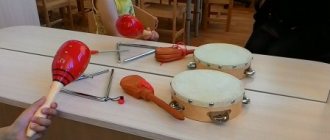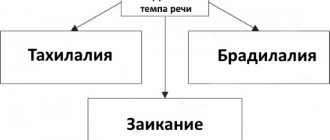Article:
Phonetic - phonemic underdevelopment of speech is a disorder of the sound-pronunciation side of speech in children and adults, caused by underdevelopment of auditory perception with normal biological hearing.
Phonetic-phonemic underdevelopment of speech (hereinafter referred to as FFSD) can be either an independent speech disorder or part of the structure of a defect, for example, in stuttering, aphasia, and is also the cause of poor learning at school. Without good sufficiency of phonemic perception, the formation of its highest level - sound analysis - is impossible. The formation of phonemic analysis and synthesis is an operation of separation and determination of the sequence in the internal plan of the constituent elements (phonemes) of individual sound complexes: syllables and words.
FFNR: concept, signs
When diagnosing, it is important to distinguish the defect in question from other speech therapy disorders.
According to the etiological factor, FFNR is distinguished:
- congenital (genetic predisposition, complicated pregnancy and childbirth);
- acquired (traumatic brain injuries, pedagogical neglect, psychological problems).
The classification according to the severity of the defect is presented in the diagram:
This conclusion is made in the absence of mechanical damage to the organs of the articulatory apparatus, with a good vocabulary and sufficiently developed coherent speech. The results of the examination are recorded in a special document - a speech card. The dynamics of the correctional impact are also reflected here.
Play speech therapy
Due to their age, children have a hard time with traditional classes, where the teacher and they sit at tables. Game speech therapy creates special conditions that allow all lessons to be conducted in an unconventional way.
Speech development in older preschoolers through play activities
A speech therapist works with a child in different areas - on the sofa, the floor or under the table. The specialist uses soap suds, papers and other materials. Outdoor games give way to quiet moments.
Touch pools can be made from cereals and decorated with small figures
For example, a speech therapy lesson on the topic “Transport” can be conducted with different cars and roads. If the weather is good, you can go outside. Such interesting lessons are conducted in an open form, and the child can choose what to do.
Theme "Spring"
Each lesson should be devoted to a specific topic, and this allows you to select tasks that will develop all aspects of speech. The speech therapist must write a summary that will allow him to build the structure of the lesson.
By the end of kindergarten, children should know the seasons and months of the year well. “Spring” speech therapy classes in the preparatory group are held in March or April.
They discuss the thematic picture with the children, ask for words in the plural (puddle-puddles, drop-drops, etc.) and ask them to name the same words in an affectionate form.
It is better to discuss the spring topic outside in warm weather. Then children will be able to clearly see what time of year it is. If there is a park nearby, then you need to go there. This way, preschoolers will become well acquainted with the theme “Spring”.
Theme "Transport"
For the lesson, you can use a presentation that is played on the computer. Such activities allow you to diversify studies in the senior preschool group.
First, the types of cars are discussed with the children, then they are asked to classify them (ground, air, water). You can add elimination games or images with missing elements.
Important! It is advisable to include tasks on word formation: “one-many”, “say kindly”, etc.
The older group is not yet engaged in the development of sound analysis. Another activity option is to use themed toys. In this case, a separate note is needed for each child.
Theme "Dishes"
To conduct the lesson you will need a set of doll dishes. The purpose of each item and the features of its use are discussed with the children. Are they discussing options for use, for example, frying or boiling in a frying pan? Do you need plates for cooking? Do they eat it with a ladle?
You can perform various manipulations with toy dishes and are more pleasant to hold in your hands than pictures
A similar theme can be combined with the “products” theme. Then the children discuss how to prepare different foods.
Features of speech with FFND
With FFNR it is noted:
In addition, characteristic symptoms are:
- replacing or mixing sounds that are similar in phonetic sound;
- insufficient articulation;
- violation of the sequence of sounds and syllables in a word, words in a sentence;
- difficulties in breaking words into syllables;
- errors when changing words by case;
- omissions of syllables, parts of words or whole words (prepositions are often omitted).
Non-verbal symptoms: impaired concentration, increased distractibility, difficulty switching from one activity to another, emotional instability, hyperactivity, poor physical health.
Phonetic-phonemic speech disorder in children
Children with FFDD develop speech in a special way. Some sounds are distorted or replaced. The number of disrupted phonemes can reach a large number - about 20.
Some sounds may be mixed into one unintelligible sound. For example, in “Fundamentals of Preschool Speech Therapy” by Filicheva, Orlova, Tumanova, variants of this problem are given. Instead of [С] and [Ш], the averaged [Ш] sounds, and instead of [Ч], [Т] - a distorted [Ч].
This problem can manifest itself in different ways. Sometimes a preschooler correctly says a sound in an isolated position, but in speech he replaces or distorts it.
Phonetic-phonemic speech disorder in children is expressed in the fact that the baby has completely normal physiological hearing, but they do not distinguish sounds. In this case, this can be expressed in the replacement of hard sounds with soft ones, hissing with whistling ones, etc.
Classification
Before understanding FFDD in speech therapy, what it is in children, you need to understand what types of disorders experts distinguish.
Important! The speech therapist must have a good understanding of the characteristics of the child’s speech development at a given time.
At the first level, phonemic perception is primarily impaired. The prerequisites for the formation of sound analysis are not sufficiently formed.
Parents cannot always detect FFND in a child, so they need the help of a speech therapist.
At the second level, the perception of the muscles of the speech apparatus is disrupted. A preschooler does not feel the position of his tongue or lips, so he does not make a difference between some sounds.
Severity and causes of appearance
Sometimes experts distinguish FFND according to the degree of manifestation:
- Mild - several sounds are disturbed and are replaced or distorted.
- Average - more sounds from different groups are pronounced incorrectly.
- Severe - the child does not distinguish sounds by ear and cannot determine the position in a word.
Often, children with FFDD have difficulty pronouncing syllables with consonant clusters - shavings, tram, and others. Filicheva wrote the book “Fundamentals of Preschool Speech Therapy” for specialists. It contains information about the causes of speech problems.
Note! Up to a year, every baby is very sensitive to any illnesses and injuries. Many infectious diseases can negatively affect the development of the central nervous system.
It is also important how the pregnancy proceeds. If it is severe, then there is a risk of getting a non-speaking child. Prematurity or prolonged labor may cause hypoxia. When there is a lack of oxygen, brain cells begin to die.
Sometimes the early development of a baby is influenced by the environment. A small number of social contacts, a large abundance of computer games and television lead to the fact that the child’s speech is formed incorrectly.
Formation of grammatical structure of speech in preschool children
In childhood, children are sensitive to their surroundings. The more adults talk to them, the better, as this encourages preschoolers to talk.
Speech therapy methods for correcting FFN
To help a child successfully overcome FFN, you need to work with him according to a certain system. This should be done by a speech therapist, since each lesson is structured in a special way.
In the kindergarten, a specialist can take children every day for a short lesson - this helps speed up the process. Parents are integral participants in the process and therefore they should also work with the child at home.
Important! Only a speech therapist can correctly determine the type of disorder and create a corrective route.
In addition to the fact that work is being done on sound pronunciation, articulatory gymnastics are carried out, the exercises of which help to form the correct pronunciation of sounds. Afterwards, installation and automation are carried out.
In individual lessons, a specialist develops sound analysis skills, phrasal speech, and a lexical dictionary. Additionally, voluntary attention and memory, and speech hearing are corrected.
From early preschool age, it is important to develop the ability to distinguish different sounds. The child is played with games to guess the sound of a musical instrument, non-speech sounds (murmur of water, rain, birdsong and much more).
Main characteristics of the disease
In addition to the fact that sound pronunciation is disrupted during FFN, other mental functions also suffer. First of all, attention. It is unstable, the child is easily distracted and cannot concentrate on one thing for a long time.
The characteristics of such children should include an assessment of the level of development of all higher mental functions - memory, speech, thinking. It will be difficult for a preschooler in the middle group of kindergarten to remember material and participate in active activities.
Children with FFDD complete tasks with a large number of errors. They get tired quickly and begin to feel irritable.
Prognosis and prevention
Timely detection of violations and constant corrective work in the preschool period allows you to almost completely get rid of the problem by the first grade.
There is no point in specially treating FFNR, since minor problems are noted with such a disorder. A neurologist can prescribe supportive medications that will improve the functioning of the nervous system.
Important! Only a doctor can prescribe the course of medications and dosage.
To prevent FFND, it is necessary to work with your baby from an early age. Mom should sing to him, tell him nursery rhymes, read fairy tales, and play with him. This will stimulate his speech development.
Can FFN go away on its own?
You should not assume that if FFN is present, speech will improve on its own. On the contrary: every year the problem may get worse. According to professional speech therapists, phonemic underdevelopment of speech in modern children is one of the most difficult problems to correct.
The phonemic aspect of speech refers to the perception and distinction of different sounds (phonemes). Disorders of phonemic speech development can be varied:
- It is difficult for a child to analyze sounds that he pronounces incorrectly. For example, if a child says “tyumka” instead of “bag,” then it will be extremely difficult for him to isolate the first sound in this word and say that it is “s.”
- The baby has difficulty trying to distinguish sounds that belong to different groups.
- The child is unable to determine what sounds a word consists of and what their sequence is.
- When talking, a boy or girl misses individual sounds, mixes them (they can pronounce them separately, but the words turn out to be “porridge”).
Without amateur performances
By talking about the FFF problem and ways to solve it, the BrainApps team aimed to provide readers with useful information. We in no way encourage self-activity. Work on correcting phonetic-phonemic underdevelopment of a child’s speech is the prerogative of specialized specialists who have a base of theoretical knowledge and practical skills in resolving such issues.
If, after reading our article, you realized the seriousness of the problem and gained ideas about the activities of a speech therapist to solve it, then our goal has been achieved.
Features of conducting classes
Experienced speech therapists usually structure their work on overcoming speech impairment in the following way:
- Classes are conducted in strict sequence, according to a specific schedule.
- The specialist studies: in what conditions the child lives, what kind of life his family leads, how adults talk. It is possible that they may also have FFN defects associated with phonemic pronunciation problems.
- During classes, the speech therapist eliminates unnecessary sound load: phones, TV or radio are turned off. The child should be in a calm, quiet environment.
- For a child with speech developmental disabilities, it is recommended to follow the correct daily routine, when rest alternates with varied activities, and enough time is allocated for sleep.
The following activities contribute to the successful work to eliminate FFF in the development of children’s speech:
- Folding puzzles, cutting pictures.
- Exercises with counting sticks (you can use matches, cutting off the heads). They are used to make different figures, ornaments, and houses.
- The baby is taught to distinguish between speech and non-speech sounds. For example: the sounds of a vacuum cleaner, tractor, washing machine, the clinking of coins in a piggy bank, the rustling of a newspaper.
Difficulties in pronunciation "r" and r"
One of the common problems of FFN with difficulties with phonemic speech is pronouncing words with the sound “r”. The terms denoting this type of FFN for phonemic difficulties in speech development are rhotacism and pararotacism. Rotacism can be different:
- A child’s tongue vibrates from the side, so it turns out “rl”.
- The lips vibrate when closed and “prr” comes out (this variant of the pronunciation defect is called “coachman”).
- Instead of “r” you hear something similar to the sound “d”. (For example, “rack”, “dose”). This erroneous sound is created when the tongue hits the alveoli with its tip, although it should vibrate.
- The buccal “r” sound occurs when one or both of the baby’s cheeks vibrate. This happens because the air exhaled during pronunciation passes between the molars of the upper jaw and the lateral edge of the tongue.
For such FFN as pararotacism, the following substitutions of the sound “r” are characteristic:
- The baby pronounces the sound “v” with his lips, without vibration.
- The vowels “y” or “i” sound.
- A different sonorant sound “l” is used.
- Words with the sound “g” are born. For example, instead of “joyful” - “disgusting”.
As we noted above, parental laughter in this case will not improve the baby’s speech. This can either cause a desire to continue speaking incorrectly (they say, it’s so much fun for others), or it will irritate the child.
Forecast and methods of prevention of FFN
Early diagnosis of children with FFN and timely correction of speech disorders contributes to the complete elimination of deficiencies in sound pronunciation and the normal development of phonemic perception. Speech therapy work with children with physical disabilities should be carried out before entering school, as this will allow them to quickly master written speech.
In order to prevent the development of FFN in a child, experts recommend following the following rules of prevention:
- diagnose perinatal pathology of the fetus;
- monitor the general health and harmonious development of children;
- improve auditory attention, which contributes to the normal formation of phonemic processes;
- monitor the child’s speech and speech environment.
If a speech disorder is detected in a child, you should immediately seek help from a speech therapist.
Preventive measures and prediction of treatment results
With timely speech therapy assistance, the prognosis for FFND is favorable. Speech defects can be corrected within 1-12 months, depending on the severity of symptoms. Success in the treatment of FFND depends on the correct actions of the parents, as well as the qualifications of the speech therapist.
Preventive measures for FFNR in speech therapy include planning pregnancy, excluding contacts of a pregnant woman with infectious patients throughout the entire period of bearing a child. During pregnancy, a woman should avoid drinking alcohol, smoking, and avoid stressful situations. The cause of speech development disorders in a child can be operations during pregnancy, rapid or prolonged labor, as well as the onset of labor ahead of schedule. If pregnancy complications occur, you should definitely contact a gynecologist for examination and treatment.
An important factor in the formation of speech is the normal psychological situation in the family. If parents have conflicts, the child may react to this with a violation of speech function. Regular activities with the child, reading books, learning to write and other activities have a beneficial effect on speech development.
Alcoholism in one of the parents, as well as drug addiction, can be a provoking factor for FFND. The child experiences stress, which greatly interferes with his development. Psychological assistance should be provided to the family, as well as treatment for alcoholism and drug addiction.
When a preschooler or schoolchild exhibits manifestations of delay and underdevelopment of speech function, you should independently contact a speech therapist as early as possible. After he conducts an examination and confirms that it is FFND, corrective classes will be prescribed. Treatment is considered most effective when patients present early.
Articulation exercises
One of the areas of complex speech therapy activities to overcome speech impairment is the implementation of articulation exercises. First, the baby does them under the guidance of a speech therapist, and then independently under the supervision of his parents. Common exercises that are performed to correct phonemic problems when diagnosing FFN are the following.
For active lip work
To force the lips of a baby who has speech impairment to work, you can perform the following tasks:
- "Smile." The teeth close together, the lips stretch into a smile.
- "Kiss." The lips are pulled forward as much as possible, as if the baby wants to kiss someone and is reaching out to that person.
- Alternating “Smile” and “Kiss”. At first it is performed slowly, then with acceleration.
- "Piglet." The lips close into a tube, the child rotates them first clockwise, then counterclockwise. This exercise not only helps to overcome the FFN of children's speech, but is also actively used by adults working in the theater field or training public speaking.
To practice your tongue
To prevent and solve phonemic problems, FFN pays special attention to language. The following training is provided for him:
- "Spatula". Like a shoulder blade, the tongue is laid out wide on the lower lip. It must be held in this position for up to ten seconds.
- "Needle". You need to show your tongue, moving it out of your mouth as much as possible. At the same time, it should be tense, with a sharp tip. Hold this for up to ten seconds.
- "Let's gallop." You need to click and click your tongue.
- "Nectar". The upper lip is licked from top to bottom. The language is broad.
- “The tongue is in a tube.” Make a round slit with your tongue.







